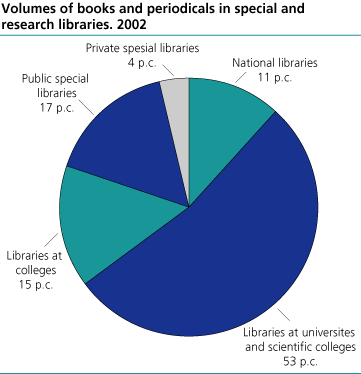Content
Published:
This is an archived release.
Special and research libraries more than books
Special and research libraries are more than only books. At the end of 2002 the libraries had a total collection of 44 million physical units and the collections seem to increase. Volumes of books and periodicals amounted to about 19 million of these units.
The registered stock of books and periodicals is almost 19 million volumes or 43 per cent of the physical units. This number represents a slight increase, about 1 per cent compared with the previous year. Libraries at universities and scientific colleges still had more than half of the registered stocks of books and periodicals. College libraries had just over 15 per cent of books and periodicals, and the national libraries had 12 per cent of stocks. Public special libraries had just over 16 per cent, while private special libraries accounted for just below 4 per cent. The physical units also include about 150 000 manuscripts, about 1.5 million microfiches, 320 000 music notes, almost 4 million units of graphic and cartographic material and more than 18 million patents.
In addition to the physical units special and research libraries have extensive collections of digital documents, databases and current title series. The digital documents represented about 8.6 million documents at the end of 2002. Most of these documents, about 7 millions are newly registered at the national libraries. At the close of 2002 just over 5 000 databases were in use at special and research libraries.
339 libraries reported figures for 2002. Even though this is fewer than 2001, the total registered collection has increased slightly compared with the previous year. However, the data collecting systems have changed and the statistics are therefore not directly t comparable with figures from previous years.
Visits increased
The number of registered visits to special and research libraries totalled just over six million in 2002. The visits increased by about 14 per cent.
University and scientific colleges accounted for almost 54 per cent of these visits, while the college libraries had 44 per cent. Private special libraries had only 0.2 per cent of visits while the public special libraries had just below 2 per cent of these. The number of visits to the college libraries increased by about 19 per cent compared with 2001.
Average number of days available to users per year was 235 days, and average weekly opening hours in a normal week were 445 hours. Professional staff was present 78 per cent of this time.
Loans
About 4 million loans were made in 2002. Of these almost 600 000 were non-local loans, while 3.4 million were local loans. These increased by around 3 per cent, while the non-local loans were declined by about 4 per cent. Non-local loans are loans between library systems under different administrative units.
Administration
Library expenditures totalled NOK 1 billion in 2002. Just about 26 per cent were used for purchases of materials for the collections. Libraries at the universities and scientific colleges accounted for more than half of the amount spent on purchases.
Just below 1 900 employees were registered at the end of 2002 at the 339 library units covered by the statistics. More than half of these held professional positions. In total, they worked just over 1 570 man-years, with professional employees accounting for 60 per cent.
The statistics for special and research libraries have been compiled by Statistics Norway and were collected in cooperation with the Norwegian Archive, Library and Museum Authority.
Tables:
Contact
-
Elisabeth Haraldsrud
E-mail: elisabeth.haraldsrud@ssb.no
tel.: (+47) 40 81 15 00
-
Line Gjermshusengen
E-mail: line.gjermshusengen@ssb.no
tel.: (+47) 40 81 13 46
-
Hilde Sofie Frydenberg
E-mail: hilde.frydenberg@ssb.no
tel.: (+47) 40 81 13 50

